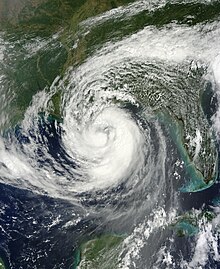
Back إعصار إسحاق (2012) Arabic Hurrikan Isaac (2012) German Huracán Isaac Spanish Ouragan Isaac (2012) French Badai Isaac 2012 ID ისააკი (ქარიშხალი) Georgian Huragan Isaac Polish Furacão Isaac (2012) Portuguese Hurricane Isaac (2012) SIMPLE சூறாவளி ஈசாக்கு (2012) Tamil
It has been suggested that Effects of Hurricane Isaac in Florida and Effects of Hurricane Isaac in Louisiana be merged into this article. (Discuss) Proposed since May 2024. |
 Isaac close to peak strength and approaching Louisiana on August 28 | |
| Meteorological history | |
|---|---|
| Formed | August 21, 2012 |
| Extratropical | September 1, 2012 |
| Dissipated | September 3, 2012 |
| Category 1 hurricane | |
| 1-minute sustained (SSHWS/NWS) | |
| Highest winds | 80 mph (130 km/h) |
| Lowest pressure | 965 mbar (hPa); 28.50 inHg |
| Overall effects | |
| Fatalities | 41 |
| Damage | $3.11 billion (2012 USD) |
| Areas affected | Leeward Islands, Puerto Rico, Hispaniola, Cuba, The Bahamas, Florida, Louisiana, Arkansas, Kentucky, Mississippi, Alabama, Missouri, Illinois, Indiana |
| IBTrACS / [1] | |
Part of the 2012 Atlantic hurricane season | |
Hurricane Isaac was a deadly and destructive tropical cyclone that came ashore in the U.S. state of Louisiana during August 2012. The ninth named storm and fourth hurricane of the annual hurricane season, Isaac originated from a tropical wave that moved off the west coast of Africa on August 16. Tracking generally west, a broad area of low pressure developed along the wave axis the next day, and the disturbance developed into a tropical depression early on August 21 while several hundred miles east of the Lesser Antilles. The system intensified into a tropical storm shortly thereafter, but high wind shear initially prevented much change in strength.
Isaac tracked between Guadeloupe and Dominica late on August 22, and then turned towards the west-northwest and entered a region favorable for intensification; it passed over Haiti and Cuba at strong tropical storm strength. A ridge of high pressure to Isaac's north intensified and turned it westward over the Florida Keys by August 26, and Isaac entered the eastern Gulf of Mexico the next day. Gradual intensification occurred, in which the system reached its peak intensity as a Category 1 hurricane, with 1-minute sustained winds of 80 mph (130 km/h), prior to making two landfalls, both at the same intensity, on the coast of Louisiana during the late evening hours of August 28 and early morning hours of August 29, respectively. The system gradually weakened once inland, but still produced a widespread tornado outbreak across the middle of the country before dissipating into an open low early on September 1.
Before it became a hurricane, Isaac produced flooding rain across much of the Lesser and Greater Antilles. Particularly hard hit was the island of Haiti, where 24 people lost their lives. Overflowing rivers led to significant structural damage and many roadways were washed away, preventing aid to the affected area. Gusty winds and rainfall were reported in Cuba, but damage was limited to a few buildings. In Florida, Isaac produced several inches of rain, leading to flooding. Strong winds knocked out power to thousands, and waves along the coast caused minor beach erosion. The most severe effects of the storm, however, occurred in Louisiana after the storm was upgraded to hurricane intensity.
Tropical storm-force sustained winds, with gusts well over hurricane strength, knocked out power to hundreds of thousands, and heavy rain led to flooding. Many dams along the coast were briefly over-topped, though they did not break completely and were later pumped to prevent failure. Gusts near hurricane intensity and heavy rain also led to widespread power outages in the neighboring state of Mississippi, and parts of Alabama recorded nearly 1 ft (300 mm) of rain. As an extratropical cyclone, Isaac produced torrential rains across Arkansas, flooding numerous streets and homes, and damaging many crops across the region. Strong winds felled downed lines and trees. Overall, Isaac caused $3.11 billion (2012 USD) in damage and led to 41 fatalities.
- ^ David M. Roth (2012). "Hurricane Isaac - August 25-September 3, 2012". Hydrometeorological Prediction Center. National Oceanic and Atmospheric Administration. Retrieved October 8, 2012.
© MMXXIII Rich X Search. We shall prevail. All rights reserved. Rich X Search